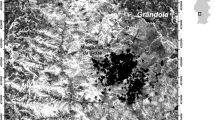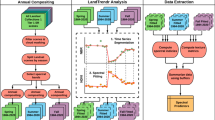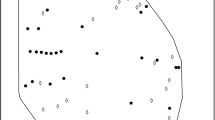Abstract
Tidal marsh monitoring and restoration can benefit from the union of fine-scale remote sensing products and field-based survey data via spatial predictive models. As part of an interdisciplinary wetland monitoring project in San Francisco Bay, we developed a suite of 1-m pixel-level spatial metrics describing patterns in marsh vegetation and geomorphology for six sites across a large salinity gradient. These metrics, based on multi-spectral aerial imagery and derived vegetation maps, provided a basis for fine-scale spatial modeling of avian habitat potential. Using common yellowthroat (Geothlypis trichas), song sparrow (Melospiza melodia), and black rail (Laterallus jamaicensis) abundance data, we developed statistical models with relatively high explanatory power. In each case, models were improved by including vegetation-map variables, but variables directly extracted from aerial imagery were more reliable indicators of avian abundance. Although results varied by species, our models achieved reasonable within-site predictive success. When predicting to sites not used in the training set, however, validation results were inconsistent and often poor, suggesting that these models should be used with caution outside of the original study sites. As remotely sensed data become more readily available, our methods may be applied to a diverse range of sites, resulting in improved model generality and applicability.



Similar content being viewed by others
References
Aldridge CL, Boyce MS (2007) Linking occurrence and fitness to persistence: Habitat-based approach for endangered greater sage-grouse. Ecological Applications 17:508–526
Atwater BF, Conrad SG, Dowden JN, Hedel CW, MacDonald RL, Savage W (1979) History, landforms, and vegetation of the estuary’s tidal marshes. In: Conomos TJ (ed) San Francisco Bay: The urbanized estuary. American Association for the Advancement of Science, San Francisco, pp 347–386
Basham MP, Mewaldt LR (1987) Salt water tolerance and the distribution of South San Francisco Bay Song Sparrows. Condor 89:697–709
Bellis LM, Pidgeon AM, Radeloff VC, St-Louis V, Navarro JL, Martella MB (2008) Modeling habitat suitability for greater rheas based on satellite image texture. Ecological Applications 18:1956–1966
Boumans RMJ, Burdick DM, Dionne M (2002) Modeling habitat change in salt marshes after tidal restoration. Restoration Ecology 10:543–555
Brotons L, Herrando S, Pla M (2007) Updating bird species distribution at large spatial scales: Applications of habitat modelling to data from long-term monitoring programs. Diversity and Distributions 13:276–288
Burnham KP, Anderson DR (2002) Model selection and multimodel inference: A practical information-theoretic approach. Springer-Verlag, New York
Conway CJ, Sulzman C (2007) Status and habitat use of the California Black Rail in the southwestern USA. Wetlands 27:987–998
Dahl TE (1990) Wetlands losses in the United States 1780’s to 1980’s. U.S. Department of the Interior, Fish and Wildlife Service, Washington, DC. http://www.npwrc.usgs.gov/resource/wetlands/wetloss/index.htm. Accessed 23 Nov 2009
ESRI (2005) ArcGIS 9.1. Environmental Systems Research Institute, Redlands, CA
ESRI (2006) ArcGIS 9.2. Environmental Systems Research Institute. Redlands, CA
Estrada-Pena A (1999) Geostatistics and remote sensing using NOAA-AVHRR satellite imagery as predictive tools in tick distribution and habitat suitability estimations for Boophilus microplus (Acari: Ixodidae) in South America. Veterinary Parasitology 81:73–82
Evans KL, James NA, Gaston KJ (2006) Abundance, species richness and energy availability in the North American avifauna. Global Ecology and Biogeography 15:372–385
Evens J, Page GW (1986) Predation on black rails during high tides in salt marshes. Condor 88:107–109
Evens J, Page GW, Laymon SA, Stallcup RW (1991) Distribution, relative abundance, and status of the California black rail in western North America. Condor 93:952–966
Gardali T, Evens JG (2008) Salt Marsh Common Yellowthroat, Geothlypis trichas sinuosa. In: Shuford WD, Gardali T (eds) California Bird Species of Special Concern: A ranked assessment of species, subspecies, and distinct populations of immediate conservation concern in California. Studies of Western Birds 1, Camarillo and Sacramento, CA, pp 346–350
Greenberg R, Droege S (1990) Adaptations to tidal marshes in breeding populations of the swamp sparrow. Condor 92:393–404
Greenberg R, Elphick C, Nordby JC, Djerdum C, Spautz H, Shriver G, Schmeling B, Olson B, Marra P, Nur N, Winter M (2006a) Flooding and predation: Trade-offs in the nesting ecology of tidal marsh sparrows. Studies in Avian Biology 32:96–109
Greenberg R, Maldonado J, Droege S, McDonald MV (2006b) Tidal marshes: A global perspective on the evolution and conservation of their terrestrial vertebrates. Bioscience 56:675–685
Hastie TJ, Tibshirani RJ (1990) Generalized additive models. Chapman & Hall, London
Hilbe J (2007) Negative binomial regression. Cambridge University Press, Cambridge
Hinkle RL, Mitsch WJ (2005) Salt marsh vegetation recovery at salt hay farm wetland restoration sites on Delaware Bay. Ecological Engineering 25:240–251
Hirano A, Madden M, Welch R (2003) Hyperspectral image data for map** wetland vegetation. Wetlands 23:436–448
Hurlbert AH (2004) Species-energy relationships and habitat complexity in bird communities. Ecology Letters 7:714–720
ITT (2003) ENVI, v. 3.6. Boulder, CO
Josselyn M (1983) The ecology of San Francisco Bay tidal marshes: A community profile. FWS/OBS-83/23. U.S. Fish and Wildlife Service, Division of Biological Services, Washington, DC
Judd C, Steinberg S, Shaughnessy F, Crawford G (2007) Map** salt marsh vegetation using aerial hyperspectral imagery and linear unmixing in Humboldt Bay, California. Wetlands 27:1144–1152
Kelly M, Meentemeyer RK (2002) Landscape dynamics of the spread of Sudden Oak Death. Photogrammetric Engineering and Remote Sensing 68:1001–1009
Kerr J, Ostrovsky M (2003) From space to species: Ecological applications for remote sensing. Trends in Ecology and Evolution 18:299–314
Lawler JJ, O’Connor RJ, Hunsaker CT, Jones KB, Loveland TR, White D (2004) The effects of habitat resolution on models of avian diversity and distributions: A comparison of two land-cover classifications. Landscape Ecology 19:517–532
Lebreton J-D, Burnham KP, Clobert J, Anderson DR (1992) Modeling survival and testing biological hypotheses using marked animals: A unified approach with case studies. Ecological Monographs 62:67–118
Leica Geosystems Inc. (2006) ERDAS Imagine
Marshal JP, Belich VC, Krausman PR, Reed ML, Andrew NG (2006) Factors affecting habitat use and distribution of desert mule deer in an arid environment. Wildlife Society Bulletin 34:609–619
Marshall J, Dedrick K (1994) Endemic song sparrows and yellowthroats of San Francisco Bay. Studies in Avian Biology 15:316–327
McGarigal K, Marks BJ (1995) FRAGSTATS: Spatial pattern analysis program for quantifying landscape structure. USDA Forest Service GTR PNW-351. http://www.umass.edu/landeco/research/fragstats/fragstats.html. Accessed 23 Nov 2009
Milsom TP, Langton SD, Parkin WK, Peel S, Bishop JD, Hart JD, Moore NP (2000) Habitat models of bird species’ distribution: An aid to the management of coastal grazing marshes. Journal of Applied Ecology 37:706–727
Neckles HA, Dionne M, Burdick DM, Roman CT, Buchsbaum R, Hutchins E (2002) A monitoring protocol to assess tidal restoration of salt marshes on local and regional scales. Restoration Ecology 10:556–563
Nichols FH, Cloern JE, Luoma SN, Peterson DH (1986) The modification of an estuary. Science 231:567–573
Nur N, Zack S, Evens J and Gardali T (1997) Tidal marsh birds of the San Francisco Bay region: Status, distribution, and conservation of five Category 2 taxa. Final draft report to National Biological Survey (now US Geological Survey). Point Reyes Bird Observatory, Stinson Beach, CA. http://www.prbo.org/cms/docs/wetlands/tmreport1997.pdf. Accessed 23 Nov 2009
Ozesmi U, Mitsch WJ (1997) A spatial habitat model for the marsh-breeding red-winged blackbird (Agelaius phoeniceus L.) in coastal Lake Erie wetlands. Ecological Modelling 101:139–152
Phinn S, Stow D, Zedler J (1996) Monitoring wetland habitat restoration in southern California using airborne multispectral video data. Restoration Ecology 4:412–422
R Development Core Team (2007) R: A language and environment for statistical computing. R Foundation for Statistical Computing, Vienna, Austria
Ralph CJ, Geupel GR, Pyle P, Martin TE, DeSante DF (1993) Handbook of field methods for monitoring landbirds. PSW-GTR-144. USDA Forest Service, Pacific Southwest Research Station, Corvallis, OR. http://www.treesearch.fs.fed.us/pubs/3639. Accessed 23 Nov 2009
Sanderson EW, Ustin SL, Foin TC (2000) The influence of tidal channels on the distribution of salt marsh plant species in Petaluma Marsh, CA, USA. Plant Ecology 146:29–41
SFEI (1998) EcoAtlas beta release, version 1.5b4. San Francisco Estuary Institute, Oakland, CA. http://www.sfei.org/ecoatlas/index.html. Accessed 2 June 2008
Shochat E, Stefanov WL, Whitehouse MEA, Faeth SH (2004) Urbanization and spider diversity: Influences of human modification of habitat structure and productivity. Ecological Applications 14:268–280
Spautz H, Nur N (2008a) Suisun Song Sparrow, Melospiza melodia maxillaris. In: Shuford WD, Gardali T (eds) California Bird Species of Special Concern: A ranked assessment of species, subspecies, and distinct populations of immediate conservation concern in California. Studies of Western Birds 1, Camarillo and Sacramento, CA, pp. 405–411
Spautz H, Nur N (2008b) Suisun Song Sparrow, Melospiza melodia samuelis. In: Shuford WD, Gardali T (eds) California Bird Species of Special Concern: A ranked assessment of species, subspecies, and distinct populations of immediate conservation concern in California. Studies of Western Birds 1, Camarillo and Sacramento, CA, pp. 412–418
Spautz H, Nur N, Stralberg D, Chan Y (2006) Multiple-scale habitat relationships of tidal marsh breeding birds in the San Francisco Bay estuary. Studies in Avian Biology 32:247–269
Spear L, Terrill SB, Lenihan C, Delevoryas P (1999) Effects of temporal and environmental factors on the probability of detecting California Black Rails. Journal of Field Ornithology 70:465–480
Suarez-Seoane S, Osborne PE, Alonso JC (2002) Large-scale habitat selection by agricultural steppe birds in Spain: Identifying species-habitat responses using generalized additive models. Journal of Applied Ecology 39:755–771
Turner MG (1989) Landscape ecology: The effect of pattern on process. Annual Review of Ecology and Systematics 20:171–197
Weinstein MP, Teal JM, Balletto JH, Strait KA (2001) Restoration principles emerging from one of the world’s largest tidal marsh restoration projects. Wetlands Ecology and Management 9:387–407
Wiegand T, Naves J, Garbulsky MF, Fernandez N (2008) Animal habitat quality and ecosystem functioning: Exploring seasonal patterns using NDVI. Ecological Monographs 78:87–103
Wood DJA, Drake S, Rushton SP, Rautenkranz D, Lurz PWW, Koprowski JL (2007) Fine-scale analysis of Mount Graham red squirrel habitat following disturbance. Journal Of Wildlife Management 71:2357–2364
Wood SN (2004) Stable and efficient multiple smoothing parameter estimation for generalized additive models. Journal of the American Statistical Association 99:673–686
Wood SN (2006) Generalized additive models: An introduction with R. Chapman and Hall/CRC Press, New York
Wu J (2004) Effects of changing scale on landscape pattern analysis: Scaling relations. Landscape Ecology 19:125–138
Zedler JB (1996) Coastal mitigation in southern California: The need for a regional restoration strategy. Ecological Applications 6:84–93
Zedler JB, Callaway JC (1999) Tracking wetland restoration: Do mitigation sites follow desired trajectories? Restoration Ecology 7:69–73
Acknowledgments
This manuscript is dedicated to the memory of Douglas Allen. We are grateful to the CALFED Bay-Delta Program for providing funding for this project (contract # P0685516), to the California Department of Fish and Game and Marin Audubon Society for administering portions of those funds, and to Stuart Siegel for coordinating the IRWM project. Several skilled field biologists—Leonard Liu, Parvaneh Abbaspour, April Robinson, Jules Evens, and Hildie Spautz—collected the avian data that made this analysis possible. Lisa Schile, Tom Parker, John Callaway, and Mike Vasey conducted invaluable vegetation surveys used to ground-truth vegetation maps. Jake Schweitzer was instrumental in processing and georectifying aerial imagery from HJW GeoSpatial, Inc., and created preliminary channel layers. Stuart Siegel and Douglas Allen provided valuable input on spatial geomorphic metrics. Samuel Valdez and Dennis Jongsomjit helped create spatial metric layers and attribute data for analysis. Julian Wood provided valuable input, and Jill Talmage helped administer contracts. This is PRBO publication #1704.
Author information
Authors and Affiliations
Corresponding author
Electronic Supplementary Material
Below is the link to the electronic supplementary material.
Supplementary Table 1
(PDF 20 kb)
Rights and permissions
About this article
Cite this article
Stralberg, D., Herzog, M.P., Nur, N. et al. Predicting Avian Abundance Within and Across Tidal Marshes Using Fine-Scale Vegetation and Geomorphic Metrics. Wetlands 30, 475–487 (2010). https://doi.org/10.1007/s13157-010-0052-8
Received:
Accepted:
Published:
Issue Date:
DOI: https://doi.org/10.1007/s13157-010-0052-8




